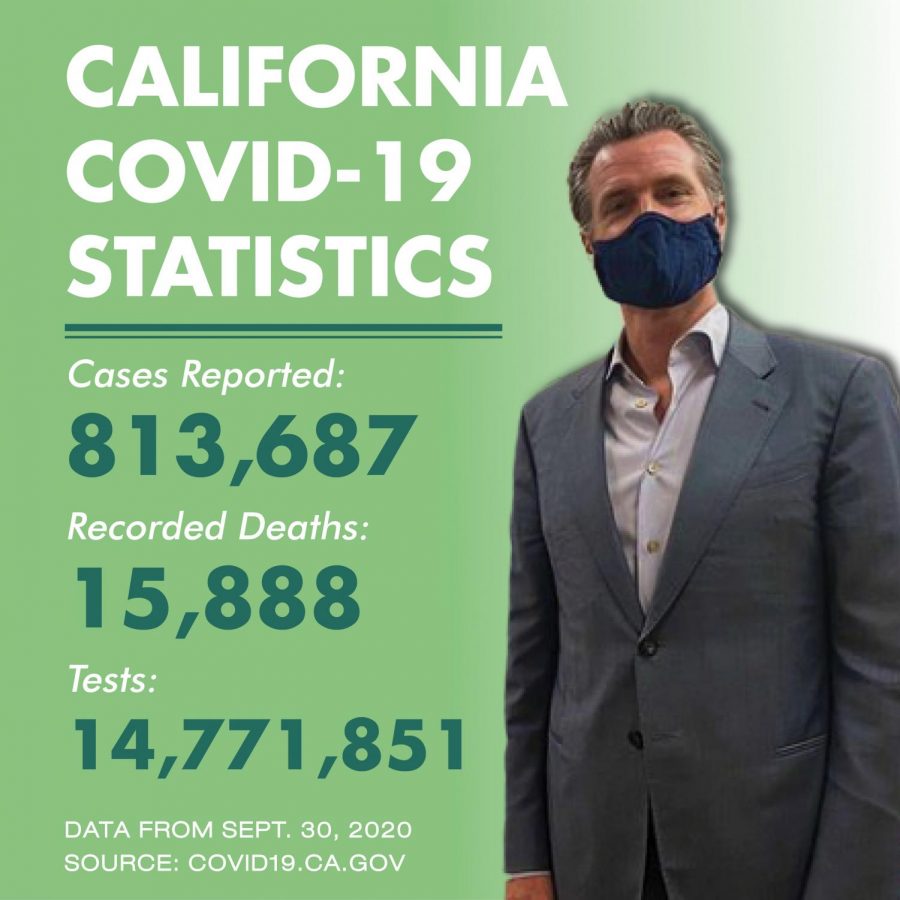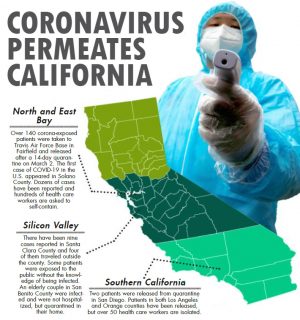Gov. Newsom’s Four-Tier Reopening Announced
Daniel Hernandez / The Advocate
The latest COVID-19 statistics for Sept. 30, 2020 released by the state of California from covid19.ca.gov. Photo of Governor Gavin Newson from Instagram @cagovernor June 10, 2020.
Oct 1, 2020
As of Aug. 31, California has 712,459 confirmed cases of COVID-19 with a 7-day average of 5,175 new cases, and Contra Costa County currently seeing 13,938 confirmed cases with 1,275 new cases over a 7-day average.
Despite the seemingly high number of new cases, the state has overall seen a steady decline in new cases compared to states such as Alabama, Idaho and both North and South Dakota, which have seen rising cases within the last month and a half, according to data acquired by The New York Times.
On the 28th of August, the Los Angeles Times released a report detailing California Governor Gavin Newsom’s new four-tier system detailing the reopening of the state in gradual stages, with a strict criterion as to what can open and how businesses and other establishments affected by the pandemic will operate. The tiers are as follows:
Tier 1, widespread transmission (the tier that most of California falls into as of Sept. 1): Most nonessential businesses will be closed, with counties in this tier having more than seven new COVID-19 cases per 100,000 people per day and have a test positivity of more than 8 percent.
Tier 2, substantial transmission: Some nonessential businesses will remain closed, but have possibilities for limited indoor dining. Counties in this tier have between four to seven COVID-19 cases per 100,00 people per day and a test positivity rate between 5 to 8 percent.
Tier 3, moderate transmission: Some businesses can open with modifications. Counties that fall into this tier have 1 to 3.9 new cases per 100,00 people per day and have a test positivity 2 to 4.9 percent.
Tier 4, minimal transmission: Most businesses can reopen with modifications. Counties that fall into this tier have less than one new case per 100,000 people per day and a test positivity rate of less than 2 percent.
Beginning on Aug. 31, hair salons and barbershops will be allowed to open statewide if they adhere to required pandemic mandates including, but not limited to, social distancing and wearing appropriate face coverings. However, under tier 1 directives, all retail stores and shopping malls will only be allowed a maximum of 25 percent capacity.
Schools, gyms and restaurants will all be largely unaffected by the new guidelines until more of California’s 58 counties reach the qualifying threshold to facilitate further reopening under tiers 2 through 4.
A separate report from the Los Angeles Times detailed that schools would have to wait for their respective counties to qualify as “substantial”, “moderate” or “minimal” levels for at least 14 days.
Once the 14-day period has passed, schools will be allowed to reopen with limited in-person instruction upon approval from local health officials.
With the current system in place, Governor Newsom hopes to be more stringent with the new system’s operations.
His administration’s initial effort in the spring saw a rapid reopening end with a surge of new COVID-19 cases and another statewide shutdown.
Another issue surrounding the pandemic is unemployment and all the concerns that come with millions of American citizens being unemployed as a result of the pandemic.
According to NPR, The California State Legislature has passed AB-3088, a bill that aims to give further protections to renters after negotiations between advocacy groups for both landlords and tenants stalled the first proposal.
With its signing by Governor Newsom, the bill will immediately go into effect and give tenants breathing room on unpaid rent between the months of March and August.
However, landlords will be allowed to sue for the back rent from that period beginning in March of 2021.
AB-3088 also states that between Sept. 1, 2020 and Jan. 31, 2021, tenants must pay at least 25 percent of their rent to be protected from eviction.
Tenants who fail to meet the minimum requirement could be evicted as soon as Feb. 1.
The rest of the United States, however, has seen a mixed bag of results since the initial shutdowns in March 2020.
As of Aug. 4, the nation has seen over 6.1 million cases and over 186,000 confirmed deaths, according to data from the CDC.
The Trump Administration’s response to the pandemic has been one of the many points of contention between Democrats and Republicans in both the House of Representatives and the Senate, as the nation continues its turbulent course toward the elections in November of this year.





melinda • Mar 15, 2021 at 3:20 pm
Gov. Newsom,
I just wanted to tell you I think you are going a great job. I will not support the recall.
Thank you for all your hard work for our state.
Melinda